And welcome to our first 5BF of November, beloved patrons!
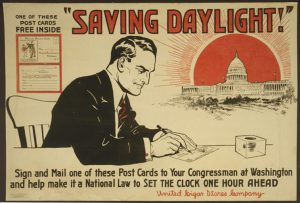
And speaking of November, don’t forget to set your clocks back an hour this Sunday, as it’s the end of Daylight Savings Time. Though we all give Benjamin Franklin credit for coming up with the idea of Daylight Savings Time, there is a debate as to whether he meant the idea as a lighthearted jest more than a practical suggestion. It was, in fact, Germany, under the reign of Kaiser Wilhelm II during the First World War, which was the first country to adopt daylight saving time – or “fast time” as it was then called – as a means to minimize artificial lighting and save fuel for the war effort. The act was quickly followed in both Great Britain and France, where it was also credited with getting in an extra hour for cultivation of war gardens. As this article in the Great Falls Tribune points out, the movement had something of a rocky start in the US:
The cause for turning the clocks back an hour in the United States was taken up by Pittsburgh industrialist Robert Garland. Garland successfully lobbied for the “Standard Time Act,” establishing that U.S. clocks be set back one hour between March 31 and Oct. 27.
The act was signed into law by President Woodrow Wilson on March 19, 1918, but was repealed just seven months later. The war had ended, and nobody seemed to like the idea, especially American dairy farmers who worked tirelessly to overturn the Standard Time Act, even overcoming a veto by Wilson.
Undaunted, Garland continued to advocate for daylight saving time. For the next 20 years, he argued before any group that would invite him that a permanent daylight saving time would improve industrial efficiency and add an additional hour so Americans could enjoy more outdoor activities such as golf, tennis and baseball. He even enlisted the support of the motion-picture industry, arguing that daylight saving would increase attendance at the theaters.
Garland’s efforts were largely unsuccessful, although several large U.S. cities including Pittsburgh, Philadelphia, Boston and New York did adopt the time switch. It wasn’t until World War II that the practice once again became universal.

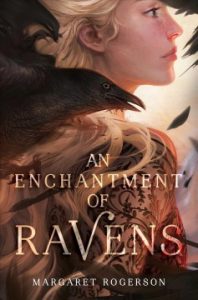 An Enchantment of Ravens: Fans of Jonathan Strange and Mr. Norrell, who loved the weird fairy settings and the talented, resourceful women who populated it, need to read Margaret Rogerson’s book. Isobel is a portrait artist with a dangerous set of clients: the sinister fair folk, who crave human Craft with a terrible thirst. Isobel’s paintings are highly prized, but when she receives her first royal patron—Rook, the autumn prince—she makes a terrible mistake. She paints mortal sorrow in his eyes—a weakness that could cost him his life. Furious and devastated, Rook spirits her away to the autumnlands to stand trial for her crime. But when the are waylaid in their journey, Isobel and Rook are forced to depend on one another for survival. Their alliance blossoms into trust, then love—and that love violates the fair folks’ ruthless laws. Now both of their lives are forfeit, unless Isobel can use her skill as an artist to fight the fairy courts. If this gorgeous cover isn’t enough to intrigue you, then come for the powerful, transformative love story, complex characters, and the simply sumptuous descriptions that make this book completely transporting. RT Book Reviews named this book a Top Pick, noting “Though Rogerson fills her tale with unique and complex characters, and her storytelling is beautiful, it is the powerful bond between her mortal heroine and her constantly surprising, supportive and fascinating hero that makes this story such a phenomenal read.”
An Enchantment of Ravens: Fans of Jonathan Strange and Mr. Norrell, who loved the weird fairy settings and the talented, resourceful women who populated it, need to read Margaret Rogerson’s book. Isobel is a portrait artist with a dangerous set of clients: the sinister fair folk, who crave human Craft with a terrible thirst. Isobel’s paintings are highly prized, but when she receives her first royal patron—Rook, the autumn prince—she makes a terrible mistake. She paints mortal sorrow in his eyes—a weakness that could cost him his life. Furious and devastated, Rook spirits her away to the autumnlands to stand trial for her crime. But when the are waylaid in their journey, Isobel and Rook are forced to depend on one another for survival. Their alliance blossoms into trust, then love—and that love violates the fair folks’ ruthless laws. Now both of their lives are forfeit, unless Isobel can use her skill as an artist to fight the fairy courts. If this gorgeous cover isn’t enough to intrigue you, then come for the powerful, transformative love story, complex characters, and the simply sumptuous descriptions that make this book completely transporting. RT Book Reviews named this book a Top Pick, noting “Though Rogerson fills her tale with unique and complex characters, and her storytelling is beautiful, it is the powerful bond between her mortal heroine and her constantly surprising, supportive and fascinating hero that makes this story such a phenomenal read.”
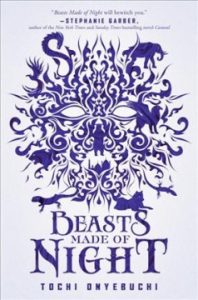 Beasts Made of Night: Another phenomenal fantasy book, this one from the African tradition, from debut author Tochi Onyebuchi, who drew on his own Nigerian heritage to write this powerful and utterly engrossing book. In the walled city of Kos, corrupt mages can magically call forth sin from a sinner in the form of sin-beasts—lethal creatures spawned from feelings of guilt. Taj is the most talented of the aki, young sin-eaters indentured by the mages to slay the sin-beasts. But Taj’s livelihood comes at a terrible cost. When he kills a sin-beast, a tattoo of the beast appears on his skin while the guilt of committing the sin appears on his mind. Most aki are driven mad by the process, but 17-year-old Taj is cocky and desperate to provide for his family. When Taj is called to eat a sin of a member of the royal family, he’s suddenly thrust into the center of a dark conspiracy to destroy Kos. Now Taj must fight to save the princess that he loves—and his own life. The lessons of self-acceptance, forgiveness, the keen understanding of what really separates the “haves” and the “have-nots”, and an utterly bewitching world all combine to make this a book that fantasy and sci-fi readers of all ages won’t want to miss! Kirkus Reviews agrees–they gave this book a starred review, noting “”Epic” is an overused term to describe how magnificent someone or something is. Author Onyebuchi’s novel creates his in the good old-fashioned way: the slow, loving construction of the mundane and the miraculous, building a world that is both completely new and instantly recognizable.”
Beasts Made of Night: Another phenomenal fantasy book, this one from the African tradition, from debut author Tochi Onyebuchi, who drew on his own Nigerian heritage to write this powerful and utterly engrossing book. In the walled city of Kos, corrupt mages can magically call forth sin from a sinner in the form of sin-beasts—lethal creatures spawned from feelings of guilt. Taj is the most talented of the aki, young sin-eaters indentured by the mages to slay the sin-beasts. But Taj’s livelihood comes at a terrible cost. When he kills a sin-beast, a tattoo of the beast appears on his skin while the guilt of committing the sin appears on his mind. Most aki are driven mad by the process, but 17-year-old Taj is cocky and desperate to provide for his family. When Taj is called to eat a sin of a member of the royal family, he’s suddenly thrust into the center of a dark conspiracy to destroy Kos. Now Taj must fight to save the princess that he loves—and his own life. The lessons of self-acceptance, forgiveness, the keen understanding of what really separates the “haves” and the “have-nots”, and an utterly bewitching world all combine to make this a book that fantasy and sci-fi readers of all ages won’t want to miss! Kirkus Reviews agrees–they gave this book a starred review, noting “”Epic” is an overused term to describe how magnificent someone or something is. Author Onyebuchi’s novel creates his in the good old-fashioned way: the slow, loving construction of the mundane and the miraculous, building a world that is both completely new and instantly recognizable.”
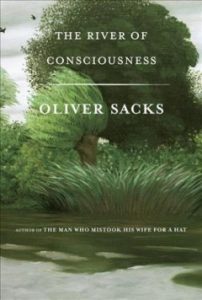 The River of Consciousness: The world lost a great deal when Oliver Sacks passed away, but his medical and literary legacy has touched countless lives. Sacks, an Oxford-educated polymath, had a deep understanding and love of not literature and medicine, though, but botany, animal anatomy, chemistry, the history of science, philosophy, and psychology. The River of Consciousness is one of two books he was working on up to his death, a series of ten essays consciously written with his own mortality in sight, and it reveals his ability to make unexpected connections, his sheer joy in knowledge, and his unceasing, timeless project to understand what makes us human. Hope Jahren, author of Lab Girl, wrote a stunning blurb for this book that says it all: “Oliver Sacks knew how much his readers would miss him, and he outlined these ten essays before he left us. Indeed, blessed are we who mourn. His was a voice that could untangle even the most formidable knots of medical mystery—the bewildering maladies of the brain—and roll them out into smooth ribbons of human story. I read these essays in one night, spellbound as he described petals, cameras, bombs—and, of course, neurons—so enraptured with details that only later did I realize how he had also explained the weightiness of time, memory, and learning itself. The River of Consciousness is the precious voice of Oliver Sacks come back to us, to do what all great seers do: lead us to places that we could never have found on our own.”
The River of Consciousness: The world lost a great deal when Oliver Sacks passed away, but his medical and literary legacy has touched countless lives. Sacks, an Oxford-educated polymath, had a deep understanding and love of not literature and medicine, though, but botany, animal anatomy, chemistry, the history of science, philosophy, and psychology. The River of Consciousness is one of two books he was working on up to his death, a series of ten essays consciously written with his own mortality in sight, and it reveals his ability to make unexpected connections, his sheer joy in knowledge, and his unceasing, timeless project to understand what makes us human. Hope Jahren, author of Lab Girl, wrote a stunning blurb for this book that says it all: “Oliver Sacks knew how much his readers would miss him, and he outlined these ten essays before he left us. Indeed, blessed are we who mourn. His was a voice that could untangle even the most formidable knots of medical mystery—the bewildering maladies of the brain—and roll them out into smooth ribbons of human story. I read these essays in one night, spellbound as he described petals, cameras, bombs—and, of course, neurons—so enraptured with details that only later did I realize how he had also explained the weightiness of time, memory, and learning itself. The River of Consciousness is the precious voice of Oliver Sacks come back to us, to do what all great seers do: lead us to places that we could never have found on our own.”
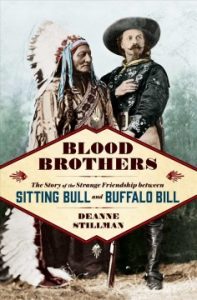 Blood Brothers: The Story of the Strange Friendship Between Sitting Bull and Buffalo Bill: It was in Brooklyn, New York, in 1883 that William F. Cody—known across the land as Buffalo Bill—conceived of his Wild West show, an “equestrian extravaganza” featuring cowboys and Indians. The idea took off. For four months in 1885 the Lakota chief Sitting Bull appeared in the show. This book, from award-winning author Deanne Stillman, tells the story of these two iconic figures through their brief but important collaboration. Unearthing little told details about the two men and their tumultuous times, this book casts light not a broad swath of 19th century American history, but also on the cultural and personal importance of Wild West Shows for Native Americans and white performers alike. During this time, the Native American rights movement began to flourish, but with their way of life in tatters, the Lakota and others availed themselves of the chance to perform in the Wild West. Cody paid his performers well, and he treated the Native Americans no differently from white performers. When Cody died in 1917, a large contingent of Native Americans attended his public funeral. This book enriches our knowledge of these two men, and the world they inhabited, in well-researched detail, and with beautiful storytelling. In it’s review, Booklist called this work “Thoroughly researched…Stillman’s account of this period in American history is elucidating as well as entertaining.”
Blood Brothers: The Story of the Strange Friendship Between Sitting Bull and Buffalo Bill: It was in Brooklyn, New York, in 1883 that William F. Cody—known across the land as Buffalo Bill—conceived of his Wild West show, an “equestrian extravaganza” featuring cowboys and Indians. The idea took off. For four months in 1885 the Lakota chief Sitting Bull appeared in the show. This book, from award-winning author Deanne Stillman, tells the story of these two iconic figures through their brief but important collaboration. Unearthing little told details about the two men and their tumultuous times, this book casts light not a broad swath of 19th century American history, but also on the cultural and personal importance of Wild West Shows for Native Americans and white performers alike. During this time, the Native American rights movement began to flourish, but with their way of life in tatters, the Lakota and others availed themselves of the chance to perform in the Wild West. Cody paid his performers well, and he treated the Native Americans no differently from white performers. When Cody died in 1917, a large contingent of Native Americans attended his public funeral. This book enriches our knowledge of these two men, and the world they inhabited, in well-researched detail, and with beautiful storytelling. In it’s review, Booklist called this work “Thoroughly researched…Stillman’s account of this period in American history is elucidating as well as entertaining.”
 Ghosts of the Tsunami: Death and Life in Japan’s Disaster Zone: On March 11, 2011, a powerful earthquake sent a 120-foot-high tsunami smashing into the coast of northeast Japan. By the time the sea retreated, more than eighteen thousand people had been crushed, burned to death, or drowned. It was Japan’s greatest single loss of life since the atomic bombing of Nagasaki. It set off a national crisis and the meltdown of a nuclear power plant. And even after the immediate emergency had abated, the trauma of the disaster continued to express itself in bizarre and mysterious ways. Richard Lloyd Parry, an award-winning foreign correspondent, lived through the earthquake in Tokyo and spent six years reporting from the disaster zone. There he encountered stories of ghosts and hauntings, and met a priest who exorcised the spirits of the dead. And he found himself drawn back again and again to one specific village that had suffered a loss too heartbreaking to forget. This is a fascinating, heartbreaking, wrenching, and wonderfully insightful book that offers a stunning portrait of a tragedy that often feels completely indescribable. As The Chicago Tribune recognized, this book is “Remarkably written and reported . . . a spellbinding book that is well worth contemplating in an era marked by climate change and natural disaster.”
Ghosts of the Tsunami: Death and Life in Japan’s Disaster Zone: On March 11, 2011, a powerful earthquake sent a 120-foot-high tsunami smashing into the coast of northeast Japan. By the time the sea retreated, more than eighteen thousand people had been crushed, burned to death, or drowned. It was Japan’s greatest single loss of life since the atomic bombing of Nagasaki. It set off a national crisis and the meltdown of a nuclear power plant. And even after the immediate emergency had abated, the trauma of the disaster continued to express itself in bizarre and mysterious ways. Richard Lloyd Parry, an award-winning foreign correspondent, lived through the earthquake in Tokyo and spent six years reporting from the disaster zone. There he encountered stories of ghosts and hauntings, and met a priest who exorcised the spirits of the dead. And he found himself drawn back again and again to one specific village that had suffered a loss too heartbreaking to forget. This is a fascinating, heartbreaking, wrenching, and wonderfully insightful book that offers a stunning portrait of a tragedy that often feels completely indescribable. As The Chicago Tribune recognized, this book is “Remarkably written and reported . . . a spellbinding book that is well worth contemplating in an era marked by climate change and natural disaster.”
